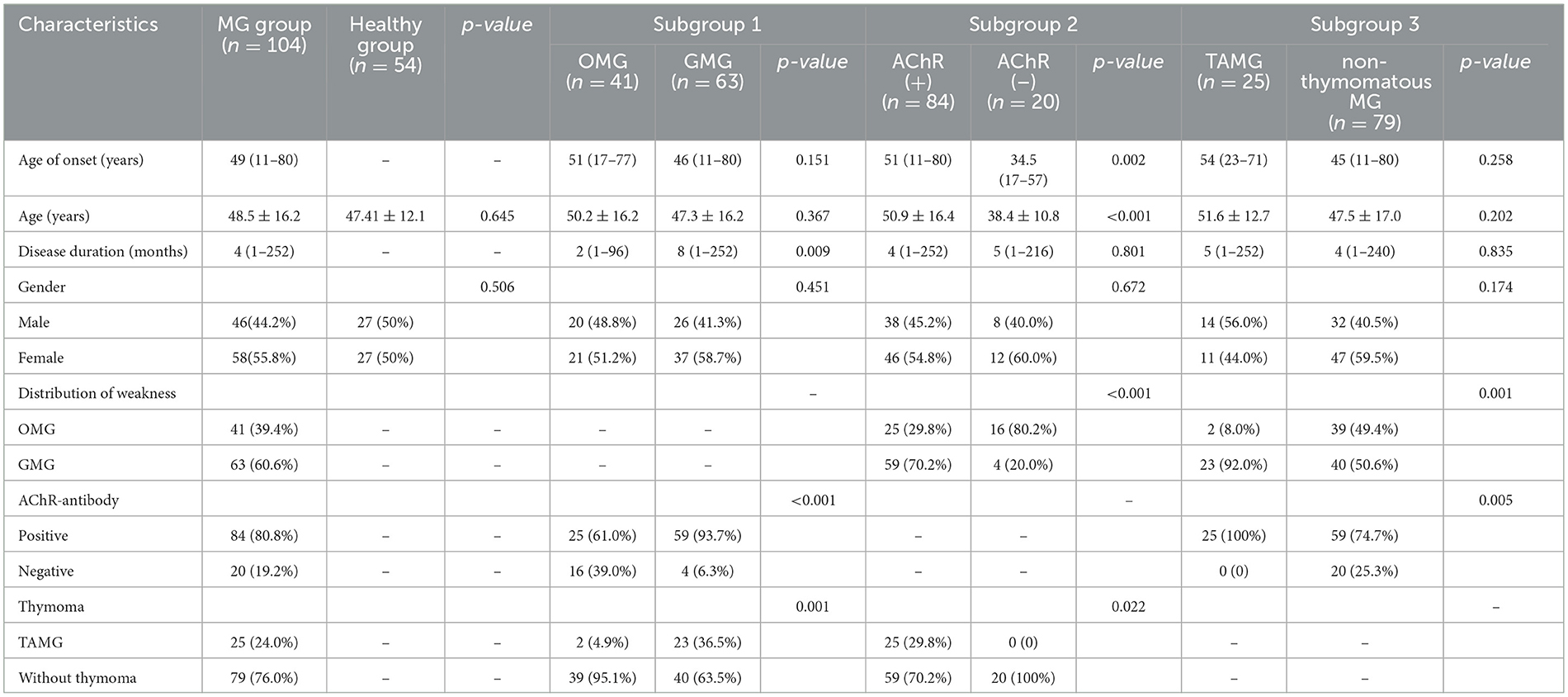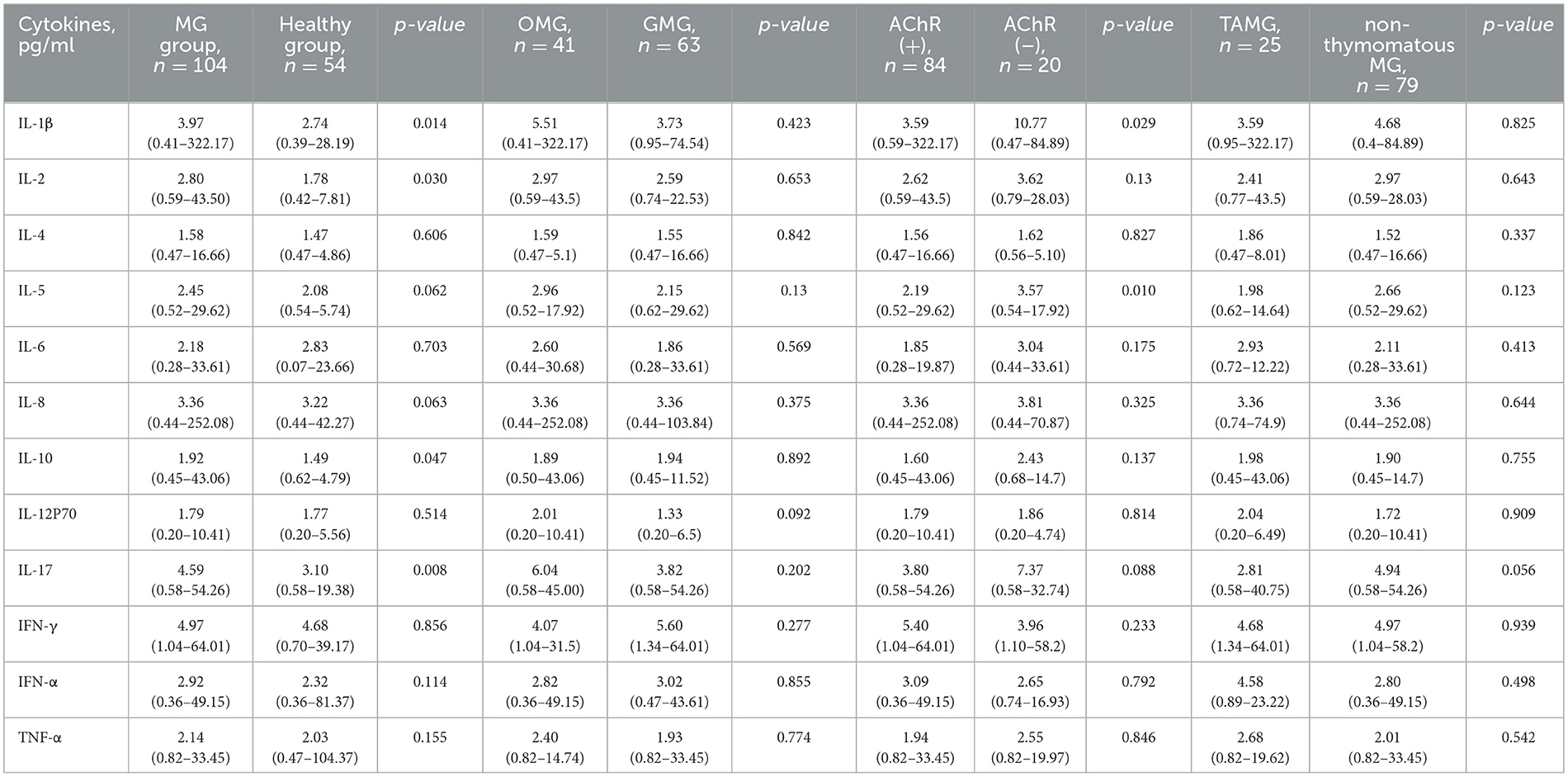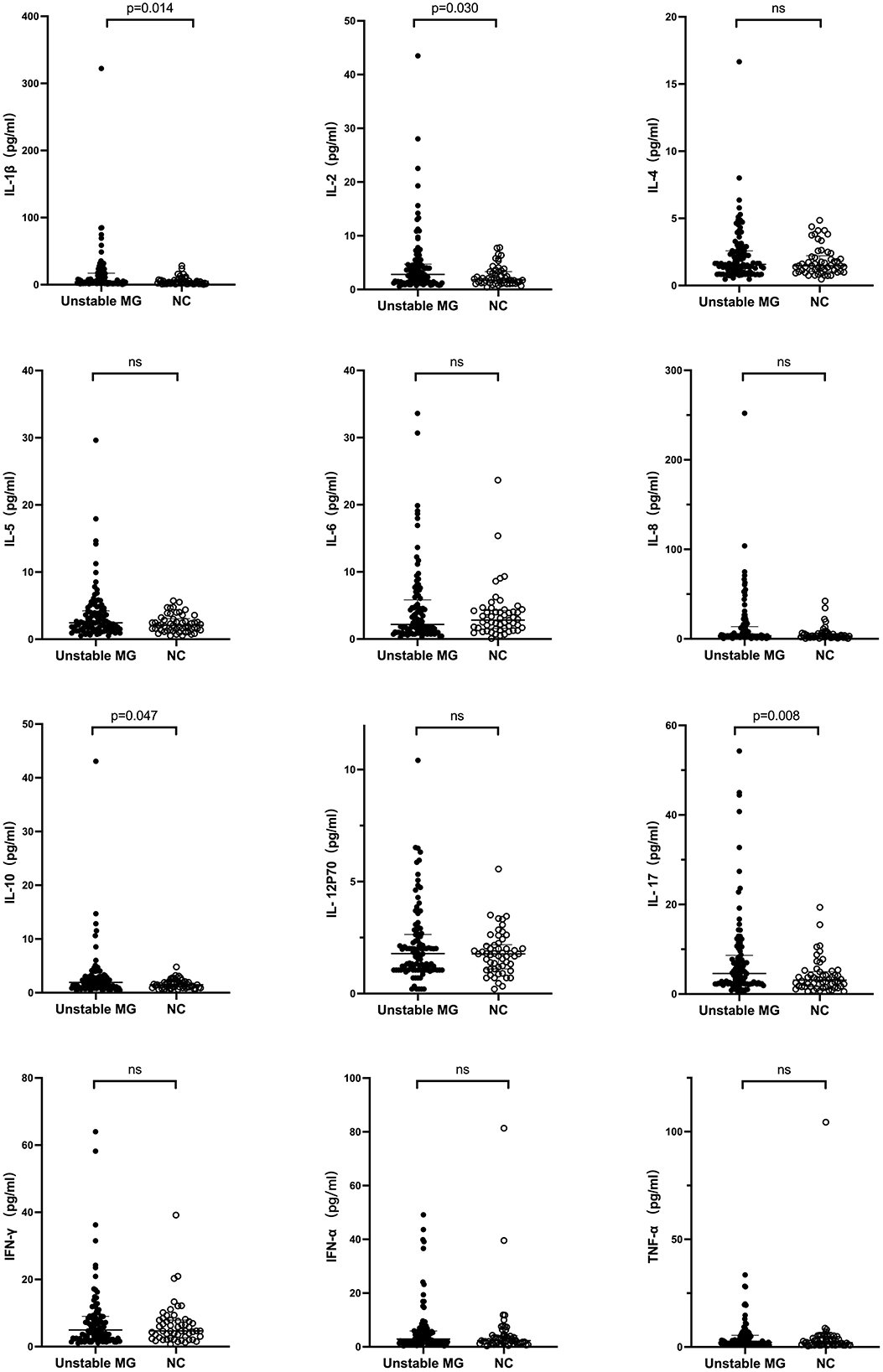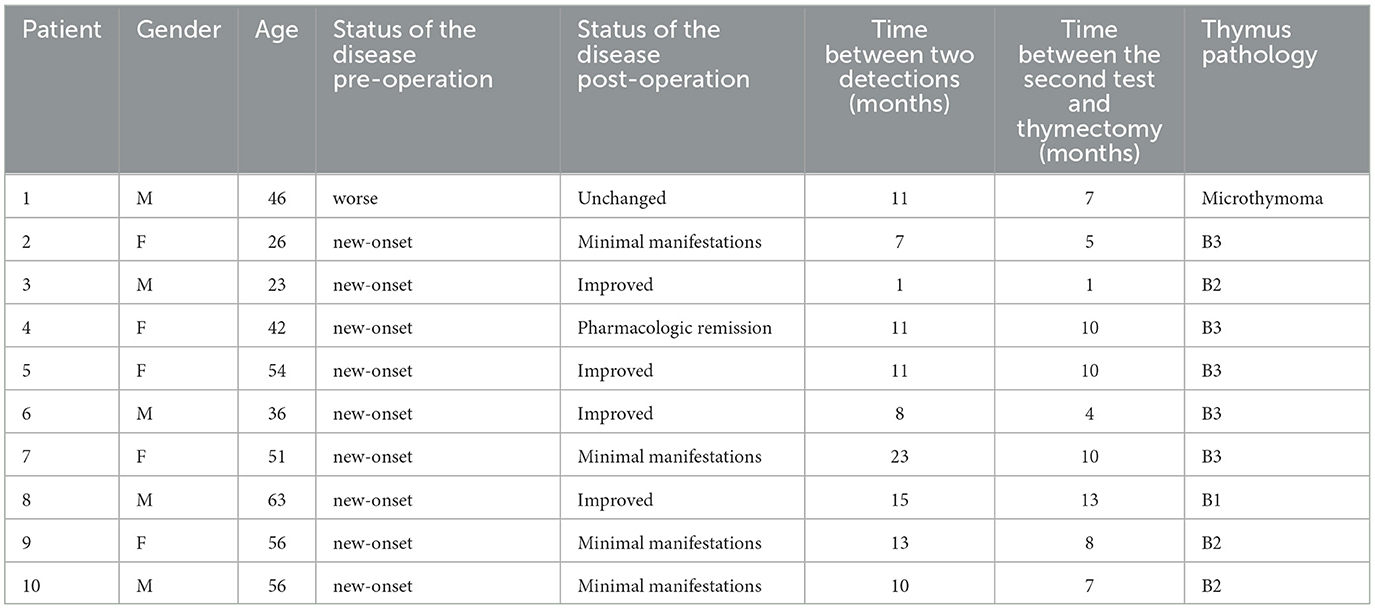- 1Department of Neurology, The First Affiliated Hospital of Fujian Medical University, Fuzhou, China
- 2Department of Neurology, National Regional Medical Center, Binhai Campus of the First Affiliated Hospital, Fujian Medical University, Fuzhou, China
- 3Department of Neurology and Institute of Neurology of First Affiliated Hospital, Institute of Neuroscience, Fujian Medical University, Fuzhou, China
Background: Cytokines play a crucial role in instigating inflammation and generating pathogenic autoantibodies at the neuromuscular junction in individuals suffering from myasthenia gravis (MG). The objective of this study is to investigate the cytokine profiles among patients grappling with MG.
Methods: This study recruited patients with unstable MG and healthy controls from the First Affiliated Hospital of Fujian Medical University during the period spanning January 2021 to December 2022. We evaluated IL-1β, IL-2, IL-4, IL-5, IL-6, IL-8, IL-10, IL-12P70, IL-17, IFN-γ, IFN-α, and TNF-α in the serum using the Flow Cytometric Bead Array (CBA) technique.
Results: A total of 104 patients and 54 healthy controls were included in the study. Notably, serum levels of interleukin (IL)-1β, IL-2, IL-10, and IL-17 exhibited significant elevation in unstable MG patients when compared to the healthy control group. Furthermore, levels of IL-1β and IL-5 were notably higher in unstable MG patients who tested negative for acetylcholine receptor (AChR) antibodies when compared to their AChR-antibody positive counterparts (P < 0.05). In AChR-antibody positive patients, there was a statistically significant decrease in IL-1β, IL-2, IL-4, IL-6, IL-8, IL-10, IL12-P70, IFN-γ, and IFN-α upon improvement. There was no discernible variation in MG patients at an unstable stage regardless of their onset time. Additionally, there was no statistically significant differences between pre- and post-thymectomy in thymoma-associated MG (TAMG).
Conclusion: Individuals with unstable MG appear to demonstrate elevated levels of serum IL-1β, IL-2, IL-10, and IL-17 compared to healthy individuals. Furthermore, among MG subgroups, those testing negative for antibodies, tend to display increased levels of IL-1β and IL-5. These serum cytokine profiles may hold promise as potential biomarkers for stratifying MG patients in clinical settings.
Introduction
Myasthenia gravis (MG) represents the most prevalent neuromuscular junction disorder, primarily instigated by pathogenic autoantibodies targeting components of the postsynaptic muscle endplate. Clinically, MG presents as muscle weakness and fatigability and is frequently accompanied by thymic abnormalities, such as follicular hyperplasia or thymoma (1, 2). In China, MG exhibits an incidence rate of 0.68 per 100,000 person-years (3). It is noteworthy that over 80% of MG patients harbor autoantibodies directed against the acetylcholine receptor (AChR) (4). These autoantibodies accelerate endocytosis, leading to AChR degradation and complement-mediated destruction of the neuromuscular junction, consequently resulting in a reduction of acetylcholine and sodium channel receptors (5). MG is categorized into two main forms: ocular myasthenia gravis (OMG) and generalized myasthenia gravis (GMG), based on the muscles affected.
Cytokines play a crucial role as critical mediators that intricately govern immune and inflammatory responses through complex networks. Additionally, they function as biomarkers for a variety of diseases (6). Additionally, T cells, B cells, plasma cells, as well as cytokines, play crucial roles in the production of AChR antibodies in MG, representing upstream components in the immunological pathogenesis of MG (3, 7, 8). Several cytokines, including interleukin (IL)-17, CXCR5, IL-21, and IL-6, among others, have been identified in the production of pathogenic autoantibodies and the inflammation observed in MG (9–11). However, numerous cytokines, characterized by their exceedingly low concentrations, remain largely unexplored. Moreover, there is limited research concerning the relationship between cytokines and distinct disease subgroups.
Thus, the primary objective of this study was to ascertain the serum levels of cytokines in patients afflicted with unstable MG, with further subdivision based on the distribution of weakness, AChR antibodies, and the presence of thymoma. Simultaneously, the alterations in cytokine levels were monitored in response to disease remission and following thymoma surgery. The study aimed to unveil the serum cytokine profiles characterizing unstable MG and potentially establish novel biomarkers for the screening and stratification of MG patient's in future clinical practice.
Methods
Study design and participants
This study recruited patients with unstable MG at the First Affiliated Hospital of Fujian Medical University between January 2021 and December 2022. The diagnosis of MG relied on clinical manifestations of fluctuating and fatigable weakness in voluntary muscles, in conjunction with at least one of the following criteria: (1) positive serum anti-AChR; (2) a decrease of more than 10% in compound muscle action potentials during repetitive nerve stimulation at frequencies of 3–5 Hz; (3) a definitive positive response to neostigmine. All patients had already been tested with AChR, muscle-specific tyrosine kinase protein (MuSK) and low-density lipoprotein receptor-related protein 4 (LRP4) antibodies. New-onset MG was defined as < 12 months since disease onset. Unstable MG was defined as either (1) the new-onset MG symptoms with no improvement since initial disease onset, or (2) suffered worse or exacerbation of post-intervention status (PIS) within 1 month (12). Exclusion criteria encompassed the presence of (1) positive serum MuSK antibodies or LRP4 antibodies; (2) concurrent uncontrolled autoimmune disorders, such as hyperthyroidism, Systemic Lupus Erythematosus (SLE), and Sjogren's syndrome; and (3) acute infections. A group of individuals without autoimmune diseases, infections, or severe underlying conditions were recruited from the health center as healthy controls.
All patients were subsequently followed up, with blood samples being collected again post-treatment upon reaching minimal manifestations status or better. Patients with thymoma underwent additional sampling following thymoma surgery.
This study garnered approval from the Ethical Review Board for Medical Research and Clinical Technology Application, Ethics Committee of the First Affiliated Hospital of Fujian Medical University. All participants provided written informed consent.
Procedures
Patients were recruited from the myasthenia gravis registration cohort at our hospital, and healthy controls were matched based on gender and age criteria corresponding to the enrolled cases. Blood samples were collected from both patients and healthy participants.
Fresh Ethylene Diamine Tetraacetic Acid (EDTA) anticoagulated whole blood samples were obtained, and serum was subsequently separated. The levels of IL-1β, IL-2, IL-4, IL-5, IL-6, IL-8, IL-10, IL-12P70, IL-17, IFN-γ, IFN-α, and TNF-α were assessed using the Flow Cytometric Bead Array (CBA) technique (13). All procedures strictly adhered to the manufacturer's instructions. If the measurement falls below the minimum detection limit, it should be recorded as the minimum detectable value. Data, including gender, age, age of onset, disease duration, MGFA Postintervention Status, anti-AChR antibody titer, anti-MuSK antibody titer, anti-LRP4 antibody titer, and the presence of thymus at the time of serum sampling, were collected.
Statistical analysis
Statistical analysis was performed using SPSS version 26.0 (IBM Corp., USA) for data analysis, and Prism 9 (GraphPad, USA) was used for generating graphs. Continuous data that adhered to a normal distribution were presented as means ± standard deviation (SD) and compared using independent t-tests and paired-samples t-tests. Continuous data exhibiting a skewed distribution were expressed as median (range) and compared using the Mann-Whitney test and Wilcoxon test. Categorical data were presented as n (%) and compared using the Fisher exact test. Subgroup analyses were conducted between OMG and GMG, AChR-antibody positive and AChR-antibody negative, and thymoma-associated MG (TAMG) and patients without thymoma (Non-thymomatous MG). AChR-antibodies were assessed using the radio immunoprecipitation assay (RIA). All TAMG cases were confirmed via surgical procedures and pathology, whereas patients without thymoma exhibited no signs of thymoma on chest CT. A two-sided P-value of < 0.05 was deemed statistically significant.
Results
A total of 104 patients were enrolled. Out of the 104 patients, 46 (44.2%) were male, and 58 (55.8%) were female. The age at disease onset ranged from 11 to 80 years, with a median of 49 years. The mean age at enrollment was 48.5 ± 16.2 years. The duration of the disease ranged from 1 to 252 months, with a median of 4 months. All patients were in an unstable state when enrolled. Among these patients, 64 (61.5%) were new-onset with MG, 15 (14.5%) experienced worse, and 25 (24.0%) were in an exacerbation phase. A total of 88 patients had not used glucocorticoids or immunosuppressant's for at least 6 consecutive months before enrollment, while nine patients had used glucocorticoids only, three patients had used tacrolimus, and four patients had received combined therapy with glucocorticoids and immunosuppressant's (three with tacrolimus and one with azathioprine). There were 25 cases of thymoma-associated MG (TAMG), with 17 cases had not yet undergone thymus surgery at the time of enrollment, and eight had previously undergone thymectomy at the time of enrollment. Among the 17 patients who had not yet undergone thymus surgery at the time of enrollment, 10 patients subsequently underwent serum cytokine detection after the thymus surgery again. The demographic and clinical characteristics of the patients are presented in Tables 1, 2.
Among the 12 different serum cytokines, significant differences were observed between all patients with unstable MG and healthy controls in the levels of IL-1β, IL-2, IL-10, and IL-17 (P < 0.05). Patients with unstable MG exhibited higher levels of these cytokines compared to healthy controls (Table 3; Figure 1). While IL-5 and IL-8 levels showed a tendency to be higher (P < 0.10) in patients with unstable MG than in healthy controls, these differences did not reach statistical significance. There were no statistically significant differences observed in any of the 12 cytokines between new-onset MG patients and patients experiencing worse or exacerbation.
Furthermore, the levels of IL-1β and IL-5 were significantly higher in the subgroup of MG patients with AChR-antibody negative compared to those with AChR-antibody positive (P < 0.05). However, there was no significant difference in any of the 12 cytokines between subgroups of OMG and GMG, TAMG, and non-thymomatous MG (all P > 0.05) (Table 3; Figure 1).
Cytokines detection was performed in 10 patients before and after thymectomy, the characteristics of these patients are presented in Table 4. There were no significant differences in any of the 12 cytokines before and after thymectomy, the change curves are shown in Figure 2.
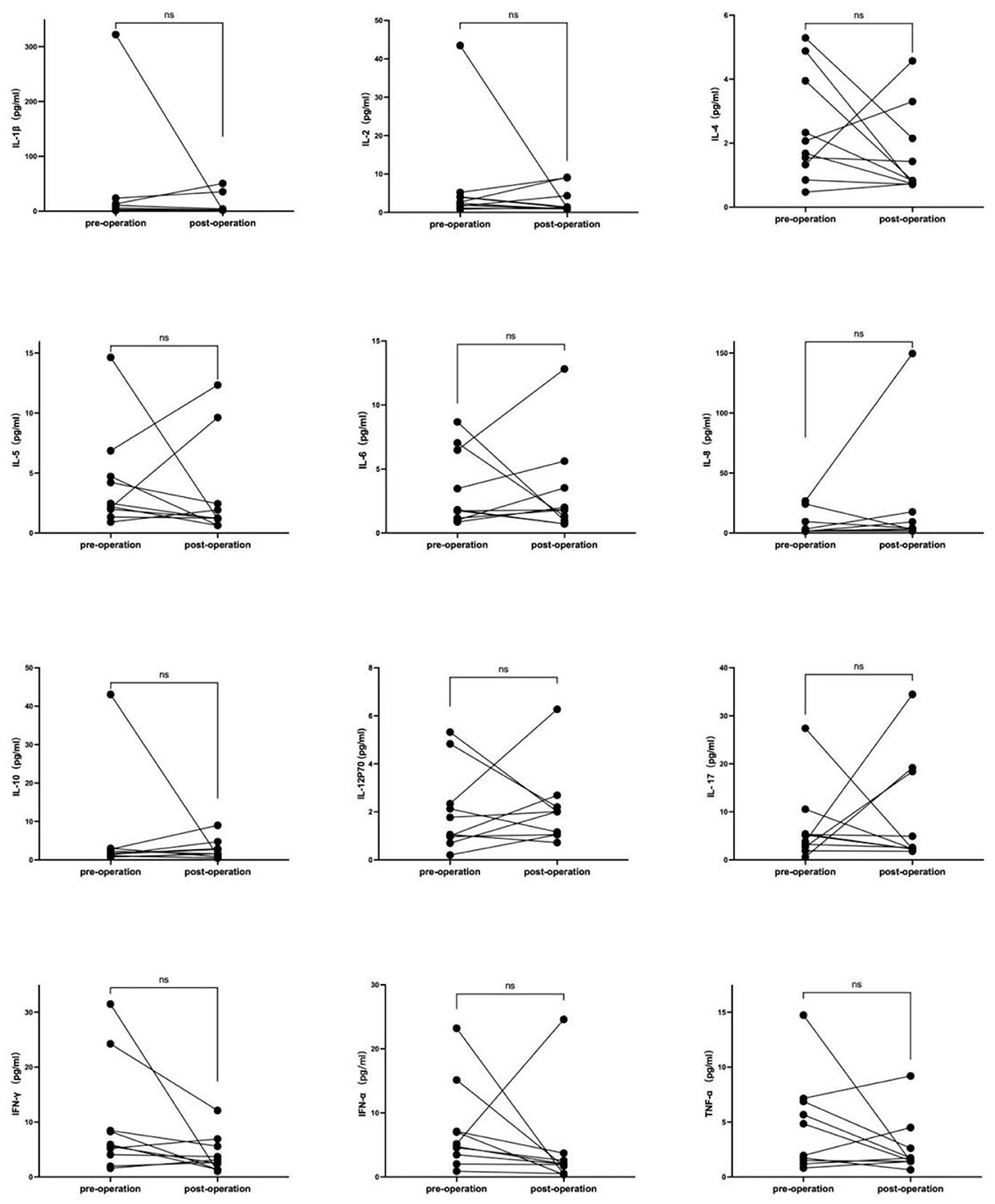
Figure 2. Serum cytokine change curves in MG patient's pre- and post- thymus surgery. Cytokines detection was performed in 10 patients before and after thymectomy, there was no significant difference in any of the 12 cytokines before and after thymectomy.
Twenty-four AChR-antibody positive, non-thymomatous, unstable MG patients had cytokines detected again after reaching minimal manifestations status or better. Among these patients, two patients underwent thymectomy during the follow-up period, with pathology indicating thymic hyperplasia. IL-1β, IL-2, IL-4, IL-6, IL-8, IL-10, IL-12P70, IFN-γ, and IFN-α showed a statistically significant decrease upon reaching minimal manifestations status or better. Conversely, there was no significant change in IL-5, IL-17, and TNF-α (Figure 3).
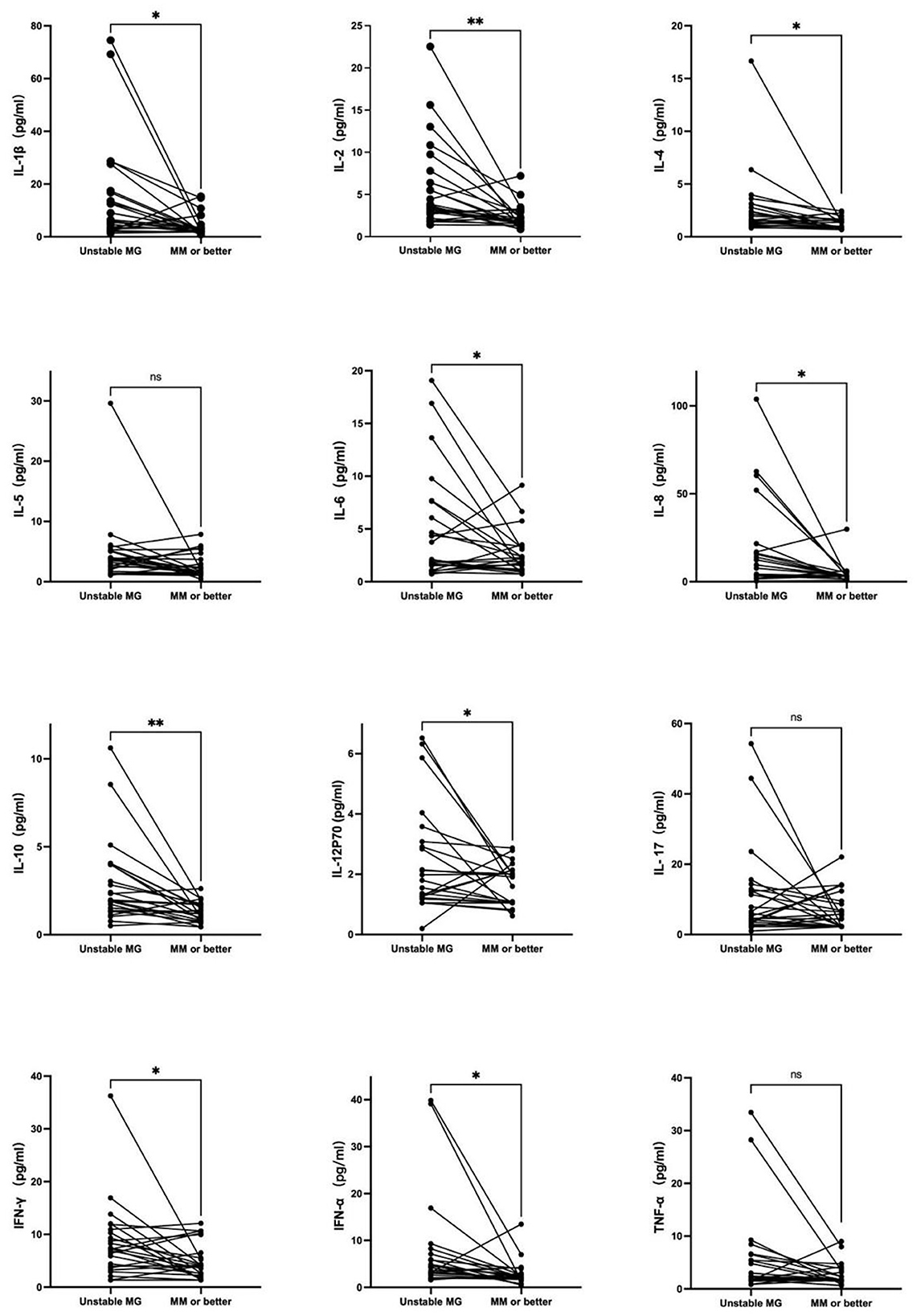
Figure 3. Twenty-four AChR-antibody positivite, non-thymomatous, unstable MG patients had cytokines detected again after reaching minimal manifestations status or better. IL-1β, IL-2, IL-4, IL-6, IL-8, IL-10, IL-12P70, IFN-γ, and IFN-α showed a statistically significant decrease upon reaching minimal manifestations status or better. Conversely, there was no significant change in IL-5, IL-17, and TNF-α. *P < 0.05, **P < 0.01.
Eight AChR-antibody negative, non-thymomatous, unstable MG patients had cytokines detected again after reaching minimal manifestations status or better. No significant changes were observed in any of the 12 cytokines, as depicted in Figure 4.
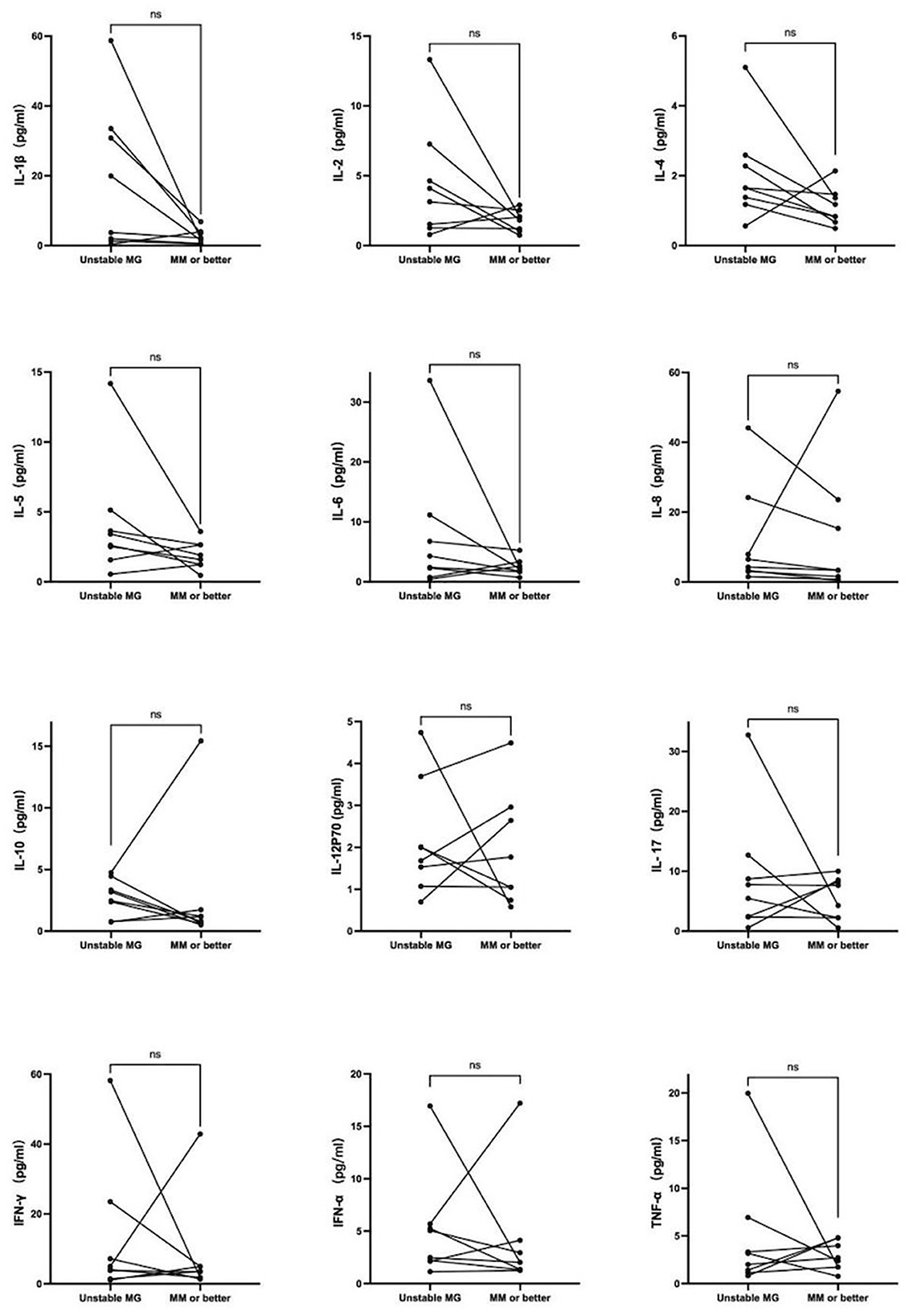
Figure 4. Eight AChR-antibody negative, non-thymomatous, unstable MG patients had cytokines detected again after reaching minimal manifestations status or better. No significant changes were observed in any of the 12 cytokines.
Discussion
This study observed that the serum levels of IL-1β, IL-2, IL-10, and IL-17 were potentially elevated in patients with unstable MG when compared to healthy individuals. Additionally, the serum levels of IL-1β and IL-5 exhibited significant increases in the subtype of MG patients with AChR-antibody negative as opposed to those with AChR-antibody positive. Additionally, a statistically significant decrease was observed in the serum levels of IL-1β, IL-2, IL-4, IL-6, IL-8, IL-10, IL-12P70, IFN-γ, and IFN-α upon reaching minimal manifestations status or better. These findings provide support for the existence of a serum cytokine profile that could serve as potential biomarkers for stratifying MG patients in clinical practice.
IL-1β plays a pivotal role as a proinflammatory cytokine involved in the regulation of the innate immune response. It has been implicated in perpetuating immune responses and contributing to conditions such as diabetic retinopathy, rheumatoid arthritis, multiple sclerosis, and Crohn's disease (14–16). Huang et al. revealed a critical role for IL-1β in inducing MG in mice, supporting its involvement in the pathogenesis of MG in humans (11). This study also demonstrated a significant increase in IL-1β levels among MG patients in an unstable stage and a statistically significant decrease when reaching stable, consistent with previous research. IL-2 serves as a vital T cell growth factor, essential for T cell proliferation and the generation of effector and memory cells (18–20). Some drugs, such as tacrolimus and cyclosporine, are used in MG primarily by inhibiting IL-2 signaling transcription (10, 21). Xiao's research demonstrated increased serum IL-2 levels in AChR-positive GMG (6), aligning with our study's findings. The role of IL-10 in MG is somewhat controversial, as it possesses both inflammatory and immunosuppressive properties (17, 22). In the present study, it was observed that IL-10 levels were markedly elevated in individuals with unstable MG compared to healthy controls, and a statistically significant reduction was noted upon achieving stability. IL-17 functions as the primary effector of Th17 cells and has been reported to be up-regulated and associated with clinical parameters of MG (22, 23), in line with the findings of this study, where IL-17 levels were significantly higher in patients with unstable MG compared to healthy controls.
IL-4 and IL-5 are categorized as type 2 cytokines (24), and although they have received relatively less attention in MG research, several studies have indicated elevated IL-4 and IL-5 levels in MG patients (9, 25–28). However, one study suggested that IL-4 may have a protective role in electromyography (EMG) (29). In our study, we did not observe significant differences in serum levels of IL-4 and IL-5 between MG patients and healthy controls. Nonetheless, there was a tendency for IL-5 levels to be higher in MG patients, and a statistically significant decrease in IL-4 levels was observed upon reaching stability. IL-8 is a type 1 cytokine and has been reported to be elevated in MG patients in multiple studies (26, 30). IL-12, an essential type 1 immune activation cytokine, consists of both the biologically inactive form (IL-12p40) and the active form (IL-12p70). The role of these two cytokines in MG has not been thoroughly investigated. While our study did not identify significant differences in serum levels of IL-8 and IL-12 between unstable MG patients and healthy controls, there was a trend toward higher IL-8 levels in MG patients, and a statistically significant decrease in IL-8 and IL-12p70 levels was observed upon reaching stability. IL-6 is a prototypical cytokine known for its pleiotropic effects on inflammation, immune response, and hematopoiesis (31). It can contribute to sustaining chronic inflammation and B cell maturation (32, 33). Studies by Revital Aricha and Akiyuki Uzawa indicated that blocking IL-6 could suppress experimental autoimmune myasthenia gravis (EAMG) and that high serum IL-6 levels were associated with disease activity in MG, respectively (34, 35). Tocilizumab, an anti-IL-6 receptor humanized monoclonal antibody, has shown effectiveness in MG cases refractory to rituximab and a prospective, open-label, single-arm study (36, 37). However, our study did not reveal significantly higher serum levels of IL-6 in unstable MG patients compared to healthy controls, but a statistically significant decrease in IL-6 levels was observed upon reaching stability. IFN-γ, IFN-α, and TNF-α are key cytokines produced by innate immune cells (17, 22). Our study found no significant differences in the levels of these three cytokines between unstable MG patients and healthy controls, but a statistically significant decrease in IFN-γ and IFN-α level was observed upon reaching stability. MG is commonly associated with autoantibodies targeting AChR, MuSK, and LRP4 (38–40).
Antibody-negative myasthenia gravis refers to cases of MG in which AChR, MuSK, or LRP4 antibodies are undetectable. Additional antibodies, such as anti-agrin and cortactin antibodies, are sometimes present in conjunction with other autoantibodies (41, 42). However, the functional relationship of these additional antibodies to other targeted proteins remains unclear. In our study, we observed that unstable MG patients who tested negative for AChR antibodies had higher serum levels of IL-1β and IL-5 compared to those who tested positive for AChR antibodies. Several cytokines exhibited a decrease in patients with minimal manifestations or improved state in AChR antibody-positive MG, whereas no such trend was observed in antibody-negative MG, suggesting distinct pathogenesis in the latter.
There were no statistically significant differences observed in any of the 12 cytokines between new-onset MG patients and patients experiencing worse or exacerbation, indicating that there was no discernible variance in the serum cytokines levels of patients with MG in an unstable stage, regardless of their onset time.
In the study, no statistically significant differences were observed in the levels of any of the 12 cytokines before and after thymectomy in patients with TAMG, suggesting that thymus may not have a substantial impact on serum cytokine levels.
This study has several limitations. Firstly, it's important to consider that AChR antibodies are the pathogenic antibodies in MG, and cytokines may play a role in pathogenesis by influencing the number of AChR-specific antibody-secreting cells. Therefore, our study primarily focused on the concentration of certain cytokines in unstable MG patients but did not delve into their effects on antigen-specific B cells, T cells, and plasma cells. Additionally, elevated levels could reflect downstream inflammation rather than disease-driving factors. Secondly, our data revealed that serum cytokine levels did not adhere to a normal distribution, displaying significant differences among different patients, with a small portion of patients registering levels below the detectable range. Thirdly, the cytokine network is intricate, with cytokines mutually influencing each other. We believe that only factors directly impacting the secretion of AChR antibodies hold the potential to predict the disease's course. Notably, Robert et al. developed an in vitro model that could serve as a paradigm for studying antibody-mediated conditions like neuromyelitis optica spectrum disorder (NMOSD) (43). This model offers the opportunity to apply condition-specific approaches to patients with antibody-mediated diseases, predicting conditions conducive to producing antibody-secreting cells (ASCs) and specific antibodies. In their work, Robert et al. observed that the percentage of ASCs was higher in conditions involving IL-1β and TNF-α compared to other conditions, and within these conditions, the proportion of detectable AQP4-IgGs was also higher, suggesting that IL-1β and TNF-α may enhance the production of serum AQP4 antibodies. This model has also been employed in the context of N-methyl-D-aspartate receptor (NMDAR) antibody encephalitis (44). In our study, we identified significant differences in serum levels of IL-1β, IL-2, IL-10, and IL-17 between unstable MG patients and healthy controls. However, in-depth in vitro models will be necessary for further validation in the future. Finally, our study is designed as a cross-sectional analysis, and not all patients underwent repeated detection during the follow-up period.
Conclusions
In summary, it appears that unstable MG patients exhibit elevated serum levels of IL-1β, IL-2, IL-10, and IL-17 compared to healthy individuals. Furthermore, the subtype of MG characterized by AChR-antibody negativity tends to demonstrate higher levels of IL-1β and IL-5 in comparison to those with AChR-antibody positivity. IL-1β, IL-2, IL-4, IL-6, IL-8, IL-10, IL-12P70, IFN-γ, and IFN-α showed a statistically significant decrease upon reaching minimal manifestations status or better in AChR-antibody positive, non-thymomatous, unstable MG patients. These findings shed light on the cytokine profiles present in the serum of unstable MG patients and suggest the potential utility of these cytokines as novel biomarkers for the screening and stratification of MG patient's in future clinical practice.
Data availability statement
The raw data supporting the conclusions of this article will be made available by the authors, without undue reservation.
Ethics statement
The studies involving humans were approved by the Ethical Review Board for Medical Research and Clinical Technology Application, Ethics Committee of the First Affiliated Hospital of Fujian Medical University. The studies were conducted in accordance with the local legislation and institutional requirements. The participants provided their written informed consent to participate in this study.
Author contributions
XW: Conceptualization, Data curation, Formal analysis, Funding acquisition, Investigation, Resources, Software, Writing – original draft, Writing – review & editing. HS: Data curation, Methodology, Resources, Writing – review & editing. GX: Data curation, Resources, Writing – original draft. RL: Data curation, Formal analysis, Investigation, Methodology, Writing – original draft. XY: Data curation, Funding acquisition, Project administration, Resources, Writing – review & editing.
Funding
The author(s) declare that financial support was received for the research and/or publication of this article. This study was supported by the Joint Funds for the Innovation of Science and Technology of Fujian Province (No. 2021Y9112), the Natural Science Foundation of Fujian Province (No. 2022J01227), and the Fujian Provincial Health Technology Project (No. 2022RKB004).
Conflict of interest
The authors declare that the research was conducted in the absence of any commercial or financial relationships that could be construed as a potential conflict of interest.
Generative AI statement
The author(s) declare that no Gen AI was used in the creation of this manuscript.
Publisher's note
All claims expressed in this article are solely those of the authors and do not necessarily represent those of their affiliated organizations, or those of the publisher, the editors and the reviewers. Any product that may be evaluated in this article, or claim that may be made by its manufacturer, is not guaranteed or endorsed by the publisher.
References
1. Uzawa A, Kawaguchi N, Himuro K, Kanai T, Kuwabara, S. Serum cytokine and chemokine profiles in patients with myasthenia gravis. Clin Exp Immunol. (2014) 176:232–37. doi: 10.1111/cei.12272
2. Villegas JA, Van Wassenhove J, Merrheim J, Matta K, Hamadache S, et al. Blocking interleukin-23 ameliorates neuromuscular and thymic defects in myasthenia gravis. J Neuroinflammation. (2023) 20:9. doi: 10.1186/s12974-023-02691-3
3. Chen J, Tian DC. Zhang, C, Li Z, Zhai Y, Xiu Y, et al. Incidence, mortality, and economic burden of myasthenia gravis in China: a nationwide population-based study. Lancet Reg Health West Pac. (2020) 5:100063. doi: 10.1016/j.lanwpc.2020.100063
4. Gilhus NE, Verschuuren JJ. Myasthenia gravis: subgroup classification and therapeutic strategies, Lancet Neurol. (2015) 14:1023–36. doi: 10.1016/S1474-4422(15)00145-3
5. Muppidi S, Utsugisawa K, Benatar M, Murai H, Barohn RJ, Illa I, et al. Long-term safety and efficacy of eculizumab in generalized myasthenia gravis. Muscle Nerve. (2019) 60:14–24. doi: 10.1002/mus.26447
6. Huan X, Zhao R. Song, J, Zhong H, Su M, Yan C, et al. Increased serum IL-2, IL-4, IL-5 and IL-12p70 levels in AChR subtype generalized myasthenia gravis. BMC Immunol. (2022) 23:26. doi: 10.1186/s12865-022-00501-8
7. Dresser L, Wlodarski R, Rezania K. Soliven, B. Myasthenia gravis: epidemiology, pathophysiology and clinical manifestations. J Clin Med. (2021) 10:11. doi: 10.3390/jcm10112235
8. Dalakas MC. Immunotherapy in myasthenia gravis in the era of biologics. Nat Rev Neurol. (2019) 15:113–24. doi: 10.1038/s41582-018-0110-z
9. Uzawa A, Kuwabara S, Suzuki, S, Imai T, Murai H, et al. Roles of cytokines and T cells in the pathogenesis of myasthenia gravis. Clin Exp Immunol. (2021) 203:366–74. doi: 10.1111/cei.13546
10. Itani K, Nakamura M, Wate, R, Kaneko S, Fujita K, et al. Efficacy and safety of tacrolimus as long-term monotherapy for myasthenia gravis. Neuromuscul Disord. (2021) 31:512–18. doi: 10.1016/j.nmd.2021.02.010
11. Huang D, Shi FD, Giscombe R, Zhou Y, Ljunggren HG, Lefvert AK. Disruption of the IL-1beta gene diminishes acetylcholine receptor-induced immune responses in a murine model of myasthenia gravis. Eur J Immunol. (2001) 31:225–32. doi: 10.1002/1521-4141(200101)31:1<225::AID-IMMU225>3.0.CO;2-0
12. Jaretzki 3rd A, Barohn RJ, Ernstoff RM, Kaminski HJ, Keesey JC, Penn AS, et al. Myasthenia gravis: recommendations for clinical research standards. Task force of the medical scientific advisory board of the myasthenia gravis foundation of America. Neurology. (2000) 55:16–23. doi: 10.1212/WNL.55.1.16
13. Medeiros NI, Gomes JAS. Cytometric Bead Array (CBA) for measuring cytokine levels in Chagas disease patients. Methods Mol Biol. (2019) 1955:309–14. doi: 10.1007/978-1-4939-9148-8_23
14. Gabay C, Lamacchia C, Palmer G. IL-1 pathways in inflammation and human diseases. Nat Rev Rheumatol. (2010) 6:232–41. doi: 10.1038/nrrheum.2010.4
15. Capitão M, Soares R. Angiogenesis and inflammation crosstalk in diabetic retinopathy. J Cell Biochem. (2016) 117:2443–53. doi: 10.1002/jcb.25575
16. Kim B, Kim HY, Yoon BR, Yeo J, In Jung J, Yu KS, et al. Cytoplasmic zinc promotes IL-1β production by monocytes and macrophages through mTORC1-induced glycolysis in rheumatoid arthritis. Sci Signal. (2022) 15:eabi7400. doi: 10.1126/scisignal.abi7400
17. Yilmaz V, Oflazer P, Aysal, F, Parman YG, Direskeneli H, et al. B cells produce less IL-10, IL-6 and TNF-α in myasthenia gravis. Autoimmunity. (2015) 48:201–7. doi: 10.3109/08916934.2014.992517
18. Abbas AK, Trotta E, Simeonov DR, Marson A, Bluestone JA. Revisiting IL-2: biology and therapeutic prospects. Sci Immunol. (2018) 3:eaat1482. doi: 10.1126/sciimmunol.aat1482
19. Malek TR. The biology of interleukin-2. Annu Rev Immunol. (2008) 26:453–79. doi: 10.1146/annurev.immunol.26.021607.090357
20. Arenas-Ramirez N, Woytschak J, Boyman O. Interleukin-2: biology, design and application. Trends Immunol. (2015) 36:763–77. doi: 10.1016/j.it.2015.10.003
21. Utsugisawa K, Nagane Y, Suzuki S, Suzuki N. Monitoring treatment with cyclosporine microemulsion in myasthenia gravis. Eur J Neurol. (2008) 15:598–604. doi: 10.1111/j.1468-1331.2008.02130.x
22. Cao Y, Amezquita RA, Kleinstein SH, Stathopoulos P, Nowak RJ, O'Connor KC. Autoreactive T cells from patients with Myasthenia gravis are characterized by elevated IL-17, IFN-γ, and GM-CSF and diminished IL-10 production. J Immunol. (2016) 196:2075–84. doi: 10.4049/jimmunol.1501339
23. Wang ZK, Wang W, Chen YP, Wei DN. Thymoma T helper type 17 cells and related cytokines in myasthenia gravis. Zhonghua Nei Ke Za Zhi. (2012) 51:540–2.
24. Gieseck 3rd RL, Wilson MS, Wynn TA. Type 2 immunity in tissue repair and fibrosis. Nat Rev Immunol. (2018) 18:62–76. doi: 10.1038/nri.2017.90
25. Conde E, Bertrand R, Balbino, B, Bonnefoy J, Stackowicz J, et al. Dual vaccination against IL-4 and IL-13 protects against chronic allergic asthma in mice. Nat Commun. (2021) 12:2574. doi: 10.1038/s41467-021-22834-5
26. Klimova EM, Drozdova LA, Lavinskaya EV, Minukhin DV, Kudrevych IO, Kudrevych OM. Genomic and epigenomic predictors for various clinical phenotypes of myasthenia gravis. Wiad Lek. (2021) 74:475–80. doi: 10.36740/WLek202103117
27. Donlan AN, Simpson ME, Petri Jr, WA. Type 2 cytokines IL-4 and IL-5 reduce severe outcomes from clostridiodes difficile infection. Anaerobe. (2020) 66:102275. doi: 10.1016/j.anaerobe.2020.102275
28. Çebi M, Durmus H. Aysal, F, Özkan B, Gül GE, Çakar A, et al. CD4(+) T cells of myasthenia gravis patients are characterized by increased IL-21, IL-4, and IL-17A productions and higher presence of PD-1 and ICOS. Front Immunol. (2020) 11:809. doi: 10.3389/fimmu.2020.00809
29. Ostlie N, Milani M, Wang W, Okita D, Conti-Fine BM. Absence of IL-4 facilitates the development of chronic autoimmune myasthenia gravis in C57BL/6 mice. J Immunol. (2003) 170:604–12. doi: 10.4049/jimmunol.170.1.604
30. Chunjie N, Huijuan N, Zhao Y, Jianzhao W, Xiaojian Z. Disease-specific signature of serum miR-20b and its targets IL-8 and IL-25, in myasthenia gravis patients. Eur Cytokine Netw. (2015) 26:61–6. doi: 10.1684/ecn.2015.0367
31. Tanaka T, Narazaki M, Kishimoto T. Interleukin (IL-6) immunotherapy. Cold Spring Harb Perspect Biol. (2018) 10:a028456. doi: 10.1101/cshperspect.a028456
32. Danikowski KM, Jayaraman S, Prabhakar BS. Regulatory T cells in multiple sclerosis and myasthenia gravis. J Neuroinflammation. (2017) 14:117. doi: 10.1186/s12974-017-0892-8
33. Bennett JL, O'Connor KC, Bar-Or A, Zamvil SS, Hemmer B, Tedder TF, et al. B lymphocytes in neuromyelitis optica. Neurol Neuroimmunol Neuroinflamm. (2015) 2:e104. doi: 10.1212/NXI.0000000000000104
34. Aricha R, Mizrachi K, Fuchs S, Souroujon MC. Blocking of IL-6 suppresses experimental autoimmune myasthenia gravis. J Autoimmun. (2011) 36:135–41. doi: 10.1016/j.jaut.2010.12.001
35. Uzawa A, Akamine H, Kojima Y, Ozawa Y, Yasuda M, Onishi Y, et al. High levels of serum interleukin-6 are associated with disease activity in myasthenia gravis. J Neuroimmunol. (2021) 358:577634. doi: 10.1016/j.jneuroim.2021.577634
36. Jonsson DI, Pirskanen R, Piehl F. Beneficial effect of tocilizumab in myasthenia gravis refractory to rituximab. Neuromuscul Disord. (2017) 27:565–8. doi: 10.1016/j.nmd.2017.03.007
37. Jia D, Zhang F, Li H, Shen Y, Jin Z, Shi FD, et al. Responsiveness to tocilizumab in anti-acetylcholine receptor-positive generalized myasthenia gravis. Aging Dis. (2024) 15:824–30. doi: 10.14336/AD.2023.0528
38. Lazaridis K, Tzartos SJ. Autoantibody specificities in myasthenia gravis; implications for improved diagnostics and therapeutics. Front Immunol. (2020) 11:212. doi: 10.3389/fimmu.2020.00212
39. Yamashita R, Shimizu M, Baba K, Beck G, Kinoshita M, Okuno T, et al. Anti-MuSK positive myasthenia gravis with Anti-Lrp4 and anti-titin antibodies. Intern Med. (2021) 60:137–40. doi: 10.2169/internalmedicine.4957-20
40. Fichtner ML, Jiang R, Bourke A, Nowak RJ, O'Connor KC. Autoimmune pathology in myasthenia gravis disease subtypes is governed by divergent mechanisms of immunopathology. Front Immunol. (2020) 11:776. doi: 10.3389/fimmu.2020.00776
41. Gasperi C, Melms A, Schoser B, Zhang Y, Meltoranta J, Risson V, et al. Anti-agrin autoantibodies in myasthenia gravis. Neurology. (2014) 82:1976–83. doi: 10.1212/WNL.0000000000000478
42. Doppler K, Hemprich A, Haarmann A, Brecht I, Franke M, Kröger S, et al. Autoantibodies to cortactin and agrin in sera of patients with myasthenia gravis. J Neuroimmunol. (2021) 356:577588. doi: 10.1016/j.jneuroim.2021.577588
43. Wilson R, Makuch M. Kienzler, AK, Varley J, Taylor J, Woodhall M, et al. Condition-dependent generation of aquaporin-4 antibodies from circulating B cells in neuromyelitis optica. Brain. (2018) 141:1063–74. doi: 10.1093/brain/awy010
Keywords: anti-AChR antibodies, cytokines profiles, thymoma, myasthenia gravis, biomarkers
Citation: Wu X, Song HH, Xu GR, Li RY and Ye XB (2025) Serum cytokine profiles in patients with myasthenia gravis. Front. Neurol. 16:1611673. doi: 10.3389/fneur.2025.1611673
Received: 14 April 2025; Accepted: 09 June 2025;
Published: 03 July 2025.
Edited by:
Corrado Italo Angelini, University of Padua, ItalyReviewed by:
Ahmet Eken, Erciyes University, TürkiyeTony Lim, University of Cambridge, United Kingdom
Copyright © 2025 Wu, Song, Xu, Li and Ye. This is an open-access article distributed under the terms of the Creative Commons Attribution License (CC BY). The use, distribution or reproduction in other forums is permitted, provided the original author(s) and the copyright owner(s) are credited and that the original publication in this journal is cited, in accordance with accepted academic practice. No use, distribution or reproduction is permitted which does not comply with these terms.
*Correspondence: Xiao Bin Ye, eXhiMTI2M0Bmam11LmVkdS5jbg==
 Xuan Wu
Xuan Wu Huan Huan Song3
Huan Huan Song3